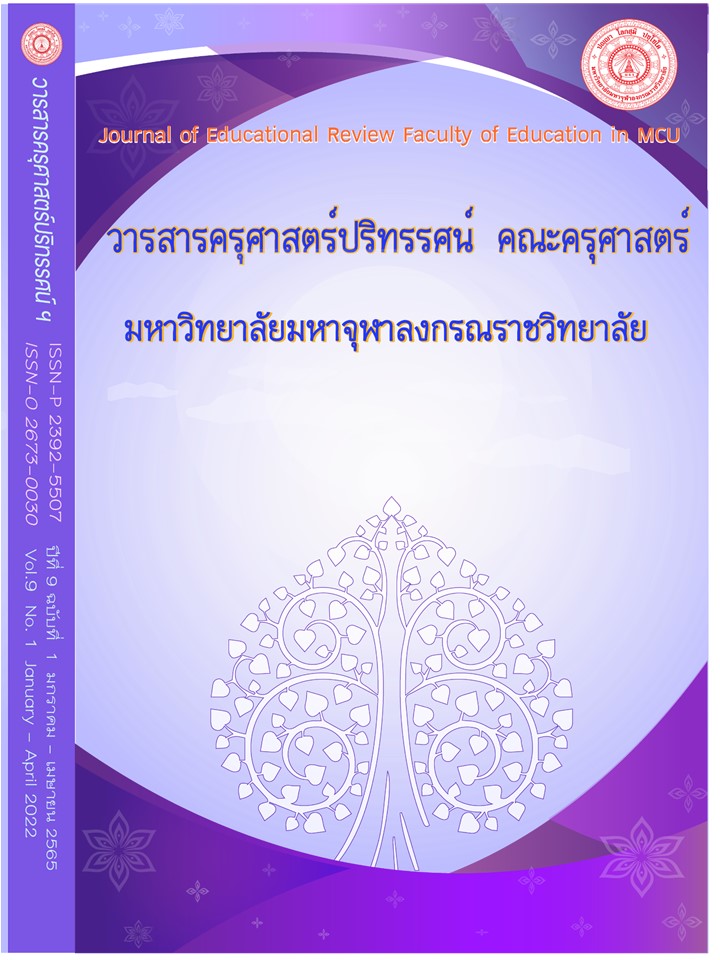A NEW SUPERVISON MODEL FOR EDUCATIONAL MANAGEMENT QUALITY DEVELOPMENT OF SCHOOLS, PATHUM THANI PRIMARY EDUCATIONAL SERVICE AREA OFFICE 2
Main Article Content
Abstract
The objectives of this research were to develop and evaluate the effectiveness of new inservice models to: Quality of educational management of educational institutions Under Pathum Thani Primary Educational Service Area Office 2 there are three stages of research: Step 1: Studying current conditions and new inservice guidelines to improve the quality of educational management of schools Under Pathum Thani Primary Educational Service Area Office 2 Step 2: create and review the form, Step 3, trial and evaluation of the model. Examples include director. Deputy Director of Academic Affairs and Teachers of The School The sample count was obtained by using the Krejcie and Morgan tables and using the Stratified Random Sampling method. The results showed that; 1) the current condition of the new inservices as a whole was the highest and the new inservice guidelines were in all 6 areas. 2) The results of the development of a new style of inservice have two elements: element 1 has three areas: (1) quality of learners (2) Quality of management and management processes (3) The quality of the teaching process focused on the learner. And element 2 is the inservice policy of Pathumthani primary educational service area office (1) Monitoring, monitoring and evaluating educational inservices with a focus on achievement, (2) monitoring inservice, administration and implementation of plans, (3) improving and improving the quality of education, (4) Coordinate, monitor, evaluate and inservice education with the Board of Directors. The inservice policy of the Office of the Basic Education Commission is (1) Integrated inservice to drive quality of education (2) Developing and implementing the principles of the school curriculum (3) Managing learning using teletechnology media (DLTV/DLIT) (4) Enhancing student achievement. 3) The overall assessment results are appropriate and the overall feasibility is at the highest level.
Article Details

This work is licensed under a Creative Commons Attribution-NonCommercial-NoDerivatives 4.0 International License.
ทัศนะและความคิดเห็นที่ปรากฏในบทความในวารสารฉบับนี้ถือเป็นความรับผิดชอบของผู้เขียนบทความนั้นเพียงผู้เดียว และไม่ถือเป็นทัศนะและความรับผิดชอบของกองบรรณาธิการ
กองบรรณาธิการขอสงวนสิทธิ์ในการคัดเลือกบทความลงตีพิมพ์และจะแจ้งให้เจ้าของบทความทราบหลังจากผู้ประเมินบทความตรวจอ่านบทความแล้ว
ต้นฉบับที่ได้รับการตีพิมพ์ในวารสารครุศาสตร์ปริทรรศน์ คณะครุศาสตร์ มหาวิทยาลัยมหาจุฬาลงกรณราชวิทยาลัย ถือเป็นกรรมสิทธิ์ของคณะครุศาสตร์ มหาวิทยาลัยมหาจุฬาลงกรณราชวิทยาลัย ห้ามนำข้อความทั้งหมดหรือบางส่วนไปพิมพ์ซ้ำ เว้นเสียแต่ว่าจะได้รับอนุญาตจากมหาวิทยาลัยฯ เป็นลายลักษณ์อักษร
References
ปฏิวัติ แก้วรัตนะ. (2558). รูปแบบการนิเทศงานวิชาการภายในของสถานศึกษาขั้นพื้นฐาน. ดุษฎีนิพนธ์ครุศาสตรดุษฎีบัณฑิต. มหาวิทยาลัยราชภัฏกาญจนบุรี.
ภัณฑิรา สุปการ. (2557). รูปแบบการบริหารจัดการการนิเทศการศึกษา สำหรับศตวรรษที่ 21. ดุษฎีนิพนธ์ปรัชญาดุษฎีบัณฑิต. มหาวิทยาลัยศิลปากร.
วัชรา เล่าเรียนดี. (2550). การนิเทศการสอน (Supervision of Instuction). นครปฐม: โรงพิมพ์มหาวิทยาลัยศิลปากร.
วิลัยพรณ์ เสรีวัฒน์. (2555). การประเมินเชิงระบบโครงการโรงเรียนมาตรฐานสากล. ดุษฎีนิพนธ์ศึกษาศาสตรดุษฎีบัณฑิต. มหาวิทยาลัยขอนแก่น.
สันติ บุญภิรมย์. (2552). การบริหารงานวิชาการ. กรุงเทพมหานคร: บุ๊คพอยท์.
สำนักงานเขตพื้นที่การศึกษาปทุมธานี เขต 2. (2563). แผนพัฒนาคุณภาพการศึกษาสำนักงานเขตพื้นที่การศึกษาปทุมธานี เขต 2. ปทุมธานี: สำนักงานเขตพื้นที่การศึกษาปทุมธานี เขต 2.
สำนักงานคณะกรรมการการศึกษาขั้นพื้นฐาน. (2562). แนวทางการนิเทศบูรณาการโดยใช้พื้นที่ เป็นฐานเพื่อพัฒนาคุณภาพการศึกษาสู่การนิเทศภายในโดยใช้ห้องเรียนเป็นฐาน. กรุงเทพมหานคร: โรงพิมพ์คุรุสภา.
สำนักงานคณะกรรมการการศึกษาแห่งชาติ. (2553). พระราชบัญญัติการศึกษาแห่งชาติ พ.ศ. 2542 (ฉบับปรับปรุง พ.ศ. 2545). พิมพ์ครั้งที่ 2. กรุงเทพมหานคร: พีเอ็นเคแอนด์สกายพริ้นติ้งส์.
สำนักงานเลขาธิการสภาการศึกษา. (2561). การบริหารงานวิชาการ. กรุงเทพมหานคร: สำนักงานเลขาธิการสภาการศึกษา.
สำนักงานศึกษาธิการจังหวัดแพร่. (2562). รูปแบบการนิเทศ ติดตามและประเมินผลการบริหารการจัดการศึกษาขั้นพื้นฐาน ที่มีความสอดคล้องเหมาะสมตามบริบทของพื้นที่ในจังหวัดแพร่. แพร่: สำนักงานศึกษาธิการจังหวัดแพร่.
สำนักทดสอบทางการศึกษา. (2563). สรุปผลการทดสอบทางการศึกษาระดับชาติขั้นพื้นฐาน (O-NET) ปีการศึกษา 2562. แหล่งที่มา www.onetresult.niets.or.th. สืบค้นเมื่อ 3 ก.ย. 2563.
Keeves, Peter J. (1988). Model and Model Building: Educational Research Methodology and Measurenment : An Intermational Handbook. Oxford: Pergamon Press.
Krejcie, R. V., & Morgan, D. W. (1970). Determining sample size for research activities. Educational and Psychological Measurement. 30(3). 607–610.


